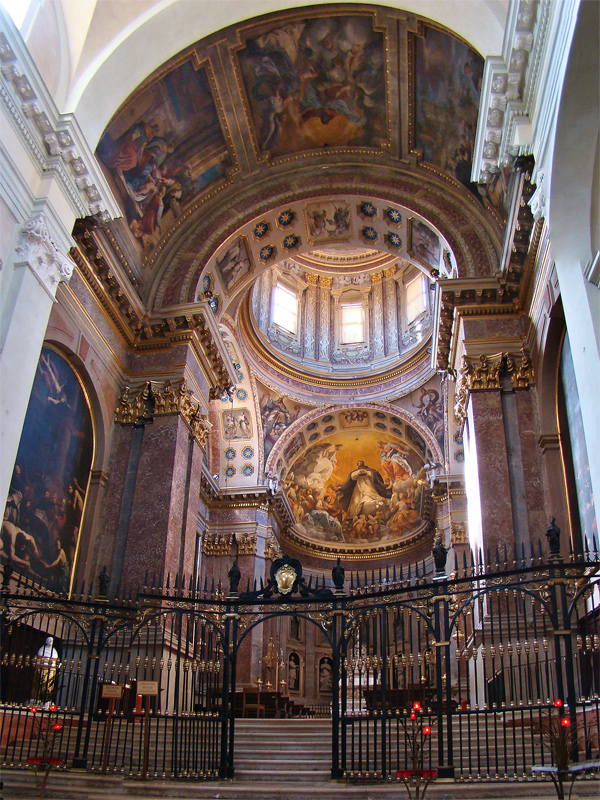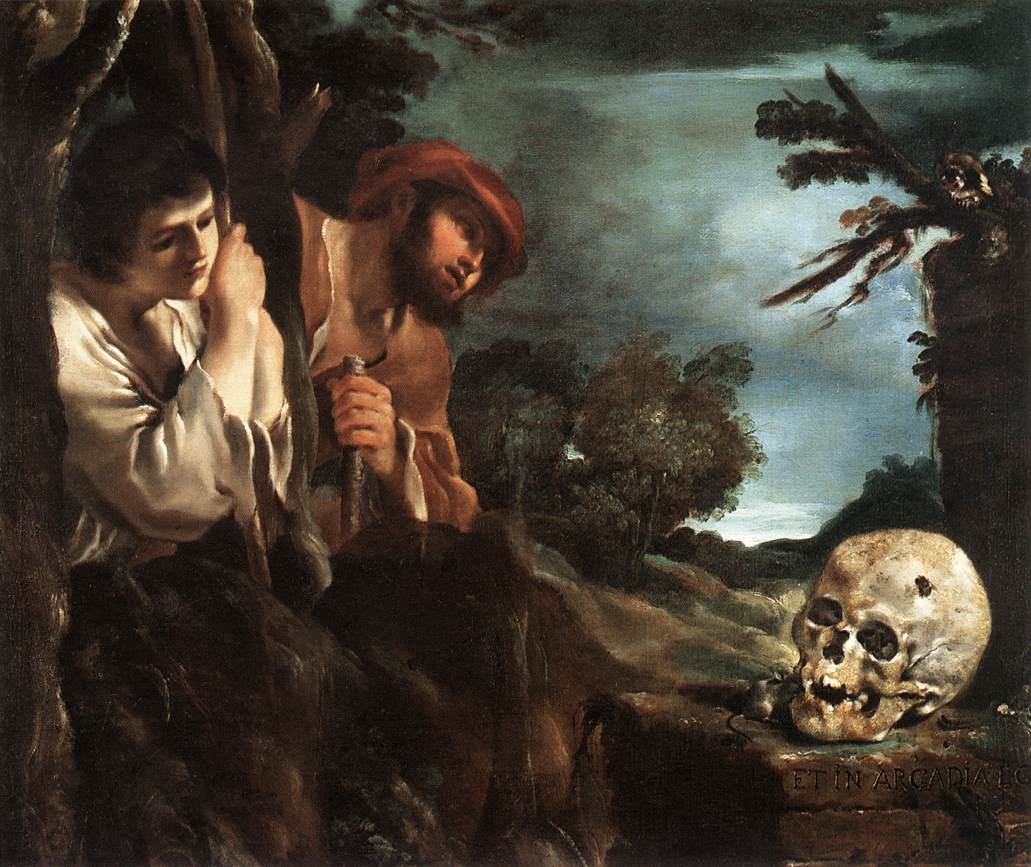|
San Domenico, Bologna
The Basilica of San Domenico is one of the major churches in Bologna, Italy. The remains of Saint Dominic, founder of the Order of Preachers ( Dominicans), are buried inside the exquisite shrine Arca di San Domenico, made by Nicola Pisano and his workshop, Arnolfo di Cambio and with later additions by Niccolò dell'Arca and the young Michelangelo. History Dominic Guzman, on arriving in Bologna in January 1218, was impressed by the vitality of the city and quickly recognized the importance of this university town to his evangelizing mission. A convent was established at the Mascarella church by the Blessed Reginald of Orleans. As this convent soon became too small for their increasing number, the preaching Brothers moved in 1219 to the small church of San Nicolò of the Vineyards at the outskirts of Bologna. St. Dominic settled in this church and held here the first two General Chapters of the order (1220 and 1221). Saint Dominic died in this church on 6 August 1221. He was buri ... [...More Info...] [...Related Items...] OR: [Wikipedia] [Google] [Baidu] |
Guercino
Giovanni Francesco Barbieri (February 8, 1591 – December 22, 1666),Miller, 1964 better known as Guercino, or il Guercino , was an Italian Baroque painter and draftsman from Cento in the Emilia region, who was active in Rome and Bologna. The vigorous naturalism of his early manner contrasts with the classical equilibrium of his later works. His many drawings are noted for their luminosity and lively style. Biography Giovanni Francesco Barbieri was born into a family of peasant farmers in Cento, a town in the Po Valley mid-way between Bologna and Ferrara.Mahon, 1937a Being cross-eyed, at an early age he acquired the nickname by which he is universally known, Guercino (a diminutive of the Italian noun '' guercio'', meaning 'squinter').Turner, 2003 Mainly self-taught, at the age of 16, he worked as apprentice in the shop of Benedetto Gennari, a painter of the Bolognese School. An early commission was for the decoration with frescos (1615–1616) of Casa Pannini in Cento, wher ... [...More Info...] [...Related Items...] OR: [Wikipedia] [Google] [Baidu] |
Emilia Bologna7 Tango7174
Emilia may refer to: People * Emilia (given name), list of people with this name Places * Emilia (region), a historical region of Italy. Reggio, Emilia * Emilia-Romagna, an administrative region in Italy, including the historical regions of Emilia and Romagna * Emilia, Łódź Voivodeship, a village in central Poland Arts * Emilia (Bulgarian singer) (born 1982), full name Emiliya Valeva, known by the mononym Emilia * Emilia (Swedish singer), full name Emilia Rydberg, also performing as Emilia Mitiku and by the mononym Emilia ** ''Emilia'' (album), 2000 self-titled album by Swedish singer Emilia Rydberg * Emilia Mernes, Argentine singer, known by the mononym Emilia * Emilia (''Sítio do Picapau Amarelo''), a fictional character of the ''Sítio do Picapau Amarelo'' series * Emilia (''Othello''), a character in Shakespeare's ''Othello'' * ''Emilia'' (TV series), a Venezuelan telenovela * ''Emilia'' (play), a 2018 play by inspired by the life of the 17th century poet and femi ... [...More Info...] [...Related Items...] OR: [Wikipedia] [Google] [Baidu] |
Baldassarre Peruzzi
Baldassare Tommaso Peruzzi (7 March 1481 – 6 January 1536) was an Italian architect and painter, born in a small town near Siena (in Ancaiano, ''frazione'' of Sovicille) and died in Rome. He worked for many years with Bramante, Raphael, and later Sangallo during the erection of the new St. Peter's. He returned to his native Siena after the Sack of Rome (1527) where he was employed as architect to the Republic. For the Sienese he built new fortifications for the city and designed (though did not build) a remarkable dam on the Bruna River near Giuncarico. He seems to have moved back to Rome permanently by 1535. He died there the following year and was buried in the Rotunda of the Pantheon, near Raphael. He was a painter of frescoes in the ''Cappella San Giovanni'' (Chapel of St John the Baptist) in the Duomo of Siena. His son Giovanni Sallustio was also an architect. Another son, Onorio, learned painting from his father, then became a Dominican priest in the convent of Santa ... [...More Info...] [...Related Items...] OR: [Wikipedia] [Google] [Baidu] |
Vitruvius
Vitruvius (; c. 80–70 BC – after c. 15 BC) was a Roman architect and engineer during the 1st century BC, known for his multi-volume work entitled ''De architectura''. He originated the idea that all buildings should have three attributes: , , and ("strength", "utility", and "beauty"). These principles were later widely adopted in Roman architecture. His discussion of perfect proportion in architecture and the human body led to the famous Renaissance drawing of the ''Vitruvian Man'' by Leonardo da Vinci. Little is known about Vitruvius' life, but by his own descriptionDe Arch. Book 1, preface. section 2. he served as an artilleryman, the third class of arms in the Roman military offices. He probably served as a senior officer of artillery in charge of ''doctores ballistarum'' (artillery experts) and ''libratores'' who actually operated the machines. As an army engineer he specialized in the construction of ''ballista'' and '' scorpio'' artillery war machines for sieges. ... [...More Info...] [...Related Items...] OR: [Wikipedia] [Google] [Baidu] |
Renaissance Style
Renaissance architecture is the European architecture of the period between the early 15th and early 16th centuries in different regions, demonstrating a conscious revival and development of certain elements of Ancient Greece, ancient Greek and Ancient Rome, Roman thought and material culture. Stylistically, Renaissance architecture followed Gothic architecture and was succeeded by Baroque architecture. Developed first in Florence, with Filippo Brunelleschi as one of its innovators, the Renaissance style quickly spread to other Italian cities. The style was carried to Spain, France, Germany, England, Russia and other parts of Europe at different dates and with varying degrees of impact. Renaissance style places emphasis on symmetry, proportion (architecture), proportion, geometry and the regularity of parts, as demonstrated in the architecture of classical antiquity and in particular ancient Roman architecture, of which many examples remained. Orderly arrangements of columns, pi ... [...More Info...] [...Related Items...] OR: [Wikipedia] [Google] [Baidu] |
Lucia Casalini-Torelli
Lucia Casalini Torelli (1677–1762) was an Italian painter, active in Bologna. The wife of painter Felice Torelli (and, through him, sister-in-law of violinist and composer Giuseppe Torelli), she was the mother of painter Stefano Torelli. She was born in Bologna, where she trained under Giovanni Gioseffo dal Sole. Life and works Daughter of Antonio Casalini and Antonia Bandiera, she began studying painting with her cousin, Carlo Casalini. However at the age of thirteen she entered the atelier of the prominent Bolognese painter, Giovanni Gioseffo Dal Sole. Here she met her future husband, also a successful painter Felice Torelli, who was regularly sent by the master to the young girl's home to bring her drawings to copy. The two married in 1701, and soon opened their own studio with students. They had seven children, two of whom, Anna and Stefano, became artists. In 1706, Felice Torelli was one of the founders of the Accademia Clementina; Lucia was elected an honorary member ... [...More Info...] [...Related Items...] OR: [Wikipedia] [Google] [Baidu] |
Lunette
A lunette (French ''lunette'', "little moon") is a half-moon shaped architectural space, variously filled with sculpture, painted, glazed, filled with recessed masonry, or void. A lunette may also be segmental, and the arch may be an arc taken from an oval. A lunette window is commonly called a ''half-moon window'', or fanlight when bars separating its panes fan out radially. If a door is set within a round-headed arch, the space within the arch above the door, masonry or glass, is a lunette. If the door is a major access, and the lunette above is massive and deeply set, it may be called a tympanum. A lunette is also formed when a horizontal cornice transects a round-headed arch at the level of the imposts, where the arch springs. If the top of the lunette itself is bordered by a hood mould it can also be considered a pediment. The term is also employed to describe the section of interior wall between the curves of a vault and its springing line. A system of intersectin ... [...More Info...] [...Related Items...] OR: [Wikipedia] [Google] [Baidu] |
Rose Window
Rose window is often used as a generic term applied to a circular window, but is especially used for those found in Gothic cathedrals and churches. The windows are divided into segments by stone mullions and tracery. The term ''rose window'' was not used before the 17th century and comes from the English flower name rose. The name "wheel window" is often applied to a window divided by simple spokes radiating from a central boss or opening, while the term "rose window" is reserved for those windows, sometimes of a highly complex design, which can be seen to bear similarity to a multi-petalled rose. Rose windows are also called "Catherine windows" after Saint Catherine of Alexandria, who was sentenced to be executed on a spiked breaking wheel. A circular window without tracery such as are found in many Italian churches, is referred to as an ocular window or oculus. Rose windows are particularly characteristic of Gothic architecture and may be seen in all the major Gothic Cathedr ... [...More Info...] [...Related Items...] OR: [Wikipedia] [Google] [Baidu] |
Romanesque Architecture
Romanesque architecture is an architectural style of medieval Europe characterized by semi-circular arches. There is no consensus for the beginning date of the Romanesque style, with proposals ranging from the 6th to the 11th century, this later date being the most commonly held. In the 12th century it developed into the Gothic style, marked by pointed arches. Examples of Romanesque architecture can be found across the continent, making it the first pan-European architectural style since Imperial Roman architecture. The Romanesque style in England and Sicily is traditionally referred to as Norman architecture. Combining features of ancient Roman and Byzantine buildings and other local traditions, Romanesque architecture is known by its massive quality, thick walls, round arches, sturdy pillars, barrel vaults, large towers and decorative arcading. Each building has clearly defined forms, frequently of very regular, symmetrical plan; the overall appearance is one of simplic ... [...More Info...] [...Related Items...] OR: [Wikipedia] [Google] [Baidu] |
Byzantine
The Byzantine Empire, also referred to as the Eastern Roman Empire or Byzantium, was the continuation of the Roman Empire primarily in its eastern provinces during Late Antiquity and the Middle Ages, when its capital city was Constantinople. It survived the fragmentation and fall of the Western Roman Empire in the 5th century AD and continued to exist for an additional thousand years until the fall of Constantinople to the Ottoman Empire in 1453. During most of its existence, the empire remained the most powerful economic, cultural, and military force in Europe. The terms "Byzantine Empire" and "Eastern Roman Empire" were coined after the end of the realm; its citizens continued to refer to their empire as the Roman Empire, and to themselves as Romans—a term which Greeks continued to use for themselves into Ottoman times. Although the Roman state continued and its traditions were maintained, modern historians prefer to differentiate the Byzantine Empire from Ancient Rome a ... [...More Info...] [...Related Items...] OR: [Wikipedia] [Google] [Baidu] |







